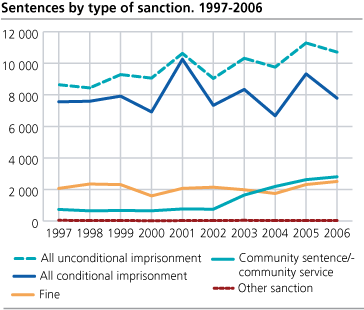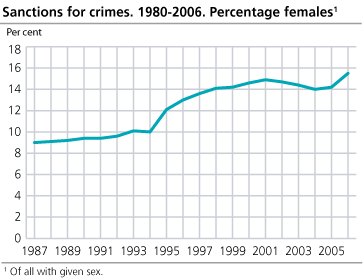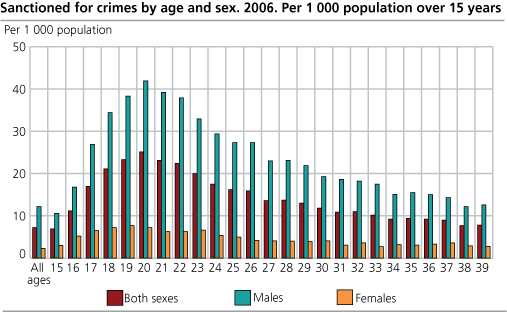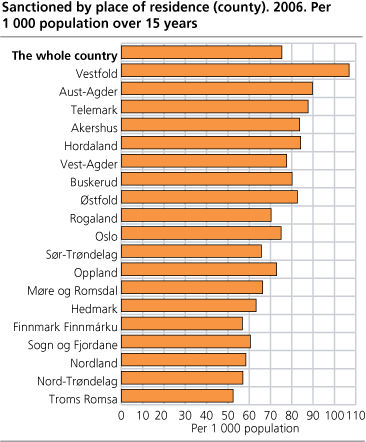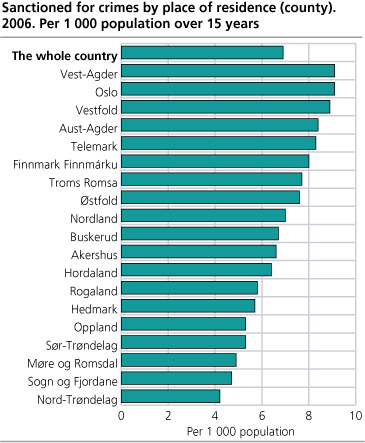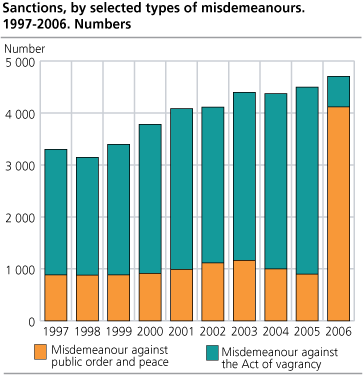Content
Published:
This is an archived release.
More women sanctioned
In 2006, 27 100 persons were sanctioned with 33 100 crimes. The number of sanctions for crimes was 0.6 per cent lower than the year before. More women and less men sanctioned with crimes entails a particularly large share of women.
298 000 persons were given 347 000 sanctions in 2006, 9.7 per cent more than the previous year.
The whole increase is due to on the spot fines for misdemeanours against the Duty Act and traffic misdemeanours, and other types of sanctions increased by only 200. On the spot fines comes to two thirds of all sanctions, and three quarters of all sanctions against misdemeanours. Combined was 7.9 per cent of the population over the age of 15 were sanctioned during 2006.
| Sanctions in crime cases, by group of crime. 1998-2006. Numbers |
| 1998 | 1999 | 2000 | 2001 | 2002 | 2003 | 2004 | 2005 | 2006 | |||||||||||||||||||||||||||||||
|---|---|---|---|---|---|---|---|---|---|---|---|---|---|---|---|---|---|---|---|---|---|---|---|---|---|---|---|---|---|---|---|---|---|---|---|---|---|---|---|
| Total | 21 128 | 22 465 | 21 444 | 34 962 | 27 513 | 29 380 | 29 529 | 33 307 | 33 103 | ||||||||||||||||||||||||||||||
| Economic crimes | 1 289 | 1 269 | 1 215 | 1 816 | 1 299 | 1 382 | 1 606 | 1 846 | 1 635 | ||||||||||||||||||||||||||||||
| Other crimes of profit | 7 281 | 7 544 | 6 658 | 9 652 | 7 376 | 8 213 | 8 217 | 9 333 | 8 919 | ||||||||||||||||||||||||||||||
| Crimes of violence | 3 414 | 3 435 | 3 195 | 5 055 | 4 186 | 4 687 | 4 826 | 5 777 | 5 419 | ||||||||||||||||||||||||||||||
| Sexual crimes | 443 | 433 | 356 | 510 | 429 | 571 | 570 | 722 | 723 | ||||||||||||||||||||||||||||||
| Crimes of narcotics | 7 004 | 8 212 | 8 374 | 14 861 | 11 894 | 12 265 | 11 815 | 12 524 | 13 245 | ||||||||||||||||||||||||||||||
| Damage to property, crimes | 757 | 625 | 715 | 1 170 | 873 | 867 | 905 | 1 049 | 1 018 | ||||||||||||||||||||||||||||||
| Other crimes1 | 940 | 947 | 931 | 1 898 | 1 456 | 1 395 | 1 590 | 2 056 | 2 144 | ||||||||||||||||||||||||||||||
| 1 | Including environment crimes. |
Most sanctions given for narcotic crimes
In 2006, 13 200 sanctions were registered with narcotic crime as principle offence, an increase of 6 per cent from 2005. Both economic crimes (1 600), other crimes for profit (8 900) and violent crimes (5 400) decreased from the previous year by respectively 11.4 and 6 per cent. Like in 2005, 700 sanctions were given against sexual crimes.
In the period 1998-2006, sanctions against crimes have increased by 57 per cent. In terms of percentage, distribution between the groups of offences is fairly the same compared to the last five years: In crime cases it is still narcotics (40 per cent), crime for profit (27 per cent) and violence (16 per cent) which is the main reason for sanction.
Fewer cases settled in court
7 per cent fewer cases were registered as settled in court in 2006 compared to previous top year 2005.
There are still 17 per cent more than in 2004, and corresponding or more sanctions than ever before in comparable statistics. Among cases settled in court, 45 per cent were unconditional imprisonment, 33 per cent conditional sentences, 12 per cent community sentence and 11 per cent were settled with fines. Conditional sentences had the largest percentage decrease from 2005 to 2006, by 17 per cent. Community sentence continues increasing by 7 per cent last year, but does not have as large increase as we have seen yearly since community sentence was introduced in 2002.
The average length of the unconditional imprisonment was somewhat lower than the previous year. In 2006, the average unconditional sentence was five months, whilst the average longest time for preventive sentences was seven years and four months. Amongst the pure unconditional sentences, 70 per cent was for up till three months, 20 per cent were between three months and up till one year, and 10 per cent exceeded one year.
Some are sanctioned more than once
13 per cent of the 298 000 sanctioned got more than one sanction in 2006, and the younger got more often several sanctions during the year than the older. Women are to a smaller extent than men sanctioned several times - where respectively 8 and 15 per cent got more than one sanction. 7 200 persons were sanctioned three or more times during 2006.
More women and fewer men
After the marked increase of the female share during the last half of the 1990's, it stabilized on about 14 per cent up till 2005 included. Compared to the previous year, however, three per cent fewer men and seven per cent more women were sanctioned for crimes. This entailed a particularly large share of women in 2006 - 15.5 per cent (see figure).
The youngest (under 20 years) and the eldest (over 40 years) contributed the most to the increased share of women in 2006. The largest decrease had the youngest men, where youth in the age group 15-17 had a decrease of 9 per cent from 2005 to 2006. Those over 40 years was the only age group among men which had an increase in number of sanctions for crimes, at 6 per cent.
More sanctions for narcotic crimes and other crime for profit, was the main reason to the total increase of female share - respectively 12 and 10 per cent. Other crime for profit had the largest decrease in number (555 fewer), but also a decrease in economic crimes (12 per cent) and violent crimes (7 per cent), contributed to the reduction in sanctions given to men. Taking the population into account, 1.2 per cent of the men, and 0.2 per cent of the women above the age of 15 years, were sanctioned for crimes in 2006.
Largest share of sanctioned for crimes in Oslo and Vest-Agder
Persons living in Oslo and Vest-Agder have most sanctioned for crimes - 9.1 per 1 000 population, in contrary to 6.9 per 1 000 population in the whole country. Of all residents in Norway who was sanctioned for crimes, 16 per cent (4 100 of 26 000) were residents in Oslo. Nord-Trøndelag had the smallest share of sanctioned, with less than half the size of shares in Oslo and in Vest-Agder. When including all misdemeanours, among them on the spot fines for traffic misdemeanours and misdemeanours against the Duty Act, 11 per cent of all residents in Vestfold were sanctioned for one or more offence in 2006, in comparison to more than five per cent among those living in Troms.
The Vagrancy Act abolished, but actions not legalised
Compared to the previous year, 38 per cent more sanctions were given for misdemeanours against the Penal Code. This whole increase is connected with the abolishment of the Vagrancy Act, and previous breaches of the Vagrancy Act are now sanctioned as breaches of the Penal Code decisions on misdemeanours against public order and peace (see text box): In 2005, 3 600 sanctions were given with misdemeanours against the Vagrancy Act as principle offence. In the first year without the Vagrancy Act, the number of sanctions on public order and peace increased by 3 200 cases - which also equals the increase in total number of misdemenaours against the Penal Code (from 7 500 to 10 400). If looking at breaches of the Vagrancy Act and public order an peace in total, 4 700 sanctions were given in 2006. This is almost 5 per cent more than the previous year, and the development since 1998 for this type of offences continues (see figure).
| Table 39 (On the spot fines for traffic misdemeanours and ticket fines based on automatic traffic control, by age and scene of crime (county). 2006. Numbers and per 1 000 population) is corrected 20 September 2007 at 11:00 a.m. |
New penalty clauses and type of offenceThe Vagrancy Act was abolished 1.1.2006, with the exception of § 11 on begging, which was abolished 1.7.2006. The Penal Code chapter 35, Misdemeanours against public order and peace, § 350 was at the same time extended to include "the one who in self-inflicted intoxication are molesting or harming others" (2. subsection). The Penal Code chapter 20, crimes concerning family relations, § 219 on ill - treatment in family relations came into force 1.1.2006. The new provisions replace to a certain extent other similar provisions on violence and threats in the Penal Code chapter 21 and 22. Registration of sanctions from these changes could be made from 11.5.2006 included (with the possibility of registering cases committed previous to this). The new penalty clauses have caused some changes in Statistics Norway's standard for type of offence, but of less importance to the contents in the standard Group of offence. |
Contact
-
Sigmund Book Mohn
E-mail: sigmund.mohn@ssb.no
tel.: (+47) 94 32 77 22
-
Reid Jone Stene
E-mail: reid.jone.stene@ssb.no
tel.: (+47) 99 02 22 01

